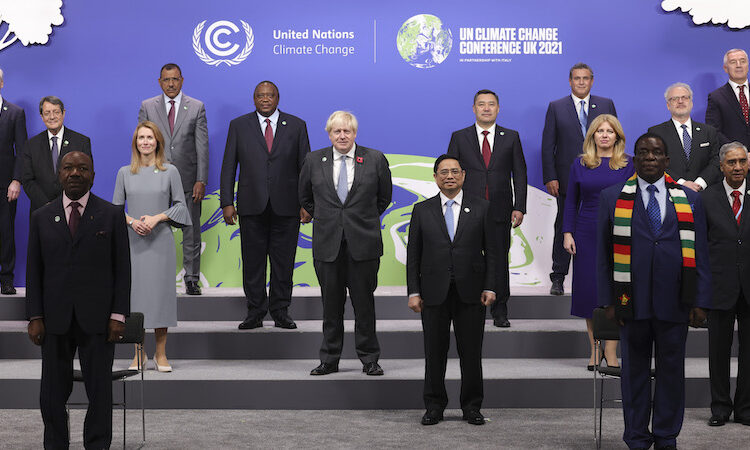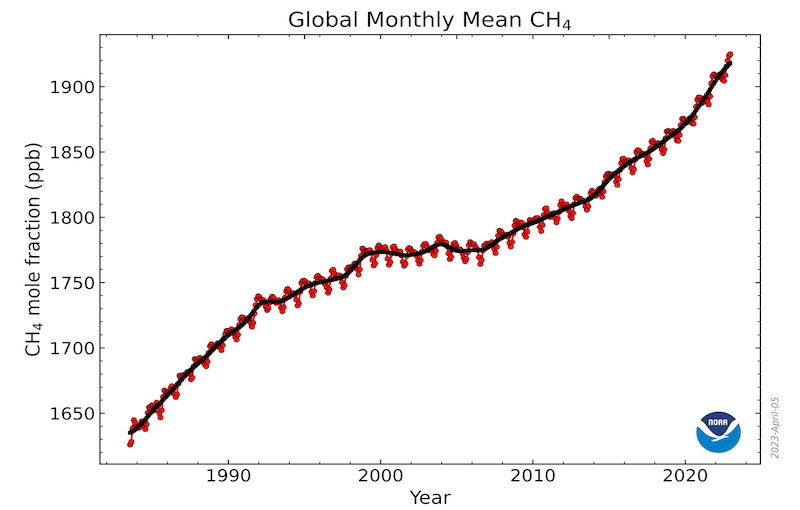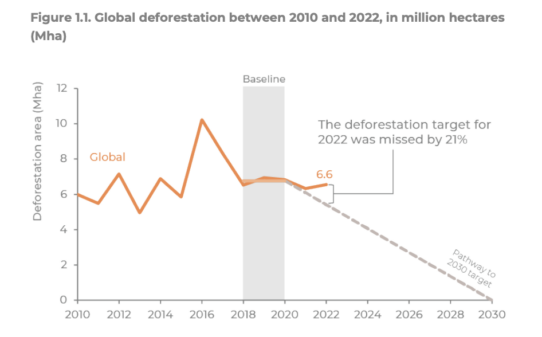
Climate Home analysed how highly-publicised commitments are faring two years on from their announcement
At Cop26 in Glasgow, hundreds of governments and private institutions joined forces in a series of pledges promising ambitious goals on methane reduction, forest protection and the shift of finance away from fossil fuels.
Nearly two years on, Climate Home News looks at how these commitments are holding up to the test of time.
METHANE PLEDGE
WHAT: Reduce human-made methane emissions by 30% between 2020 and 2030. Cutting the amount of methane present in the atmosphere is important because it is a much more powerful greenhouse gas than carbon dioxide despite having a shorter lifespan.
WHO: 104 countries, led by the US and the EU, signed up to the pledge when it was first announced at Cop26 in Glasgow. The number of signatories has since risen to 150. However, they only represent about half of global methane emissions as China, India and Russia – three of the world’s top four emitters – have not joined the coalition.
HOW IT IS GOING: The raw figures paint a fairly grim picture. Since Cop26, the concentration of methane in the atmosphere has kept rising fast and it is now more than two and a half times its pre-industrial level.
Over half of the emissions come from human activities, like fossil fuel extraction, farming and landfills, with the rest caused by natural sources. Under current trajectories, total human-made methane emissions could rise by up to 13% between 2020 and 2030 – the pledge’s timeframe.

This graph shows the globally-averaged, monthly atmospheric methane concentration since 1983. Image credit: NOAA Global Monitoring Laboratory
Targeting the oil and gas sector is seen by many as the easiest and fastest way to bring down emissions in the near term. Experts say existing technologies already provide cheap and effective ways to plug leaky infrastructure like pipelines and gas storage tanks.
However, the technological developments have not yet been converted into real, widespread action. According to the International Energy Agency (IEA), methane emissions from oil and gas remained “stubbornly high” in 2022 even as the energy companies’ bumper profits made actions to reduce them cheaper than ever. “There is just no excuse”, the IEA chief Fatih Birol commented.
Raft of initiatives
But judging the pledge’s progress on current numbers only tells half the story, argued Jonathan Banks, global director of the methane programme at the Clean Air Task Force (CATF). “Emissions are not going to turn around immediately,” he told Climate Home. “If you look at the work going into the pledge, building the funding and technical resources to bring emissions down, I think it could potentially be on track for success”.
A series of initiatives have been set up to help countries deliver on the pledge. The UN’s Climate and Clean Air Coalition (CCAC) is helping over 30 developed and developing countries to establish plans to achieve the 2030 target.
Canada has set out a strategy that it expects to reduce domestic methane emissions by “more than 35%” by 2030, compared to 2020.

Methane leaking from Chelmsford compressor station, UK on 15 October 2021, picked up by a special camera (Photo: Clean Air Task Force/ James Turitto)
The Global Methane Hub (GMH), a philanthropic organisation, is also supporting signatories of the methane pledge with technical assistance and funding. Carolina Urmeneta, a director at the GMH, told Climate Home News that over the last year, the group has focused its work on developing systems to monitor methane emissions rates from oil and gas and landfill installations using satellites.
She said reaching the 2030 target “is possible and cost-effective, but it is not easy. We need to improve data transparency and increase funding for projects with methane targets.”
Regulations drive
Some progress has also been made on the regulatory front. The USA introduced new rules to address methane emissions caused by oil and gas companies through the Inflation Reduction Act. Using a carrot-and-stick approach, it provides $1 billion in public subsidies to take action, while charging a fee for excessive emissions.
In May the European Parliament agreed on tougher measures to tackle methane emissions in the energy sector. The approved text calls for binding emission reduction targets, stronger obligations for fossil fuel operators to detect and repair leaky infrastructure and the application of the same measures to exporting countries outside of the bloc.
While the final rules are still being negotiated with the EU’s national governments, CATF’s Banks believes they could have a “huge global impact” if introduced in their current form. “The methane emissions associated with the gas Europe buys from the rest of the world is quite large, so such measures could really drive some change”.
New announcements are expected at Cop28 in Dubai, after the summit’s president Sultan Al Jaber set the phaseout of methane emissions in oil and gas by 2030 as one of his priorities. “More than 20 oil and gas companies have answered Cop28’s call,” he said this week. “And I see positive momentum as more are joining”. But the UAE has been accused of double standards as it failed to report methane emissions to the UN for a decade, as the Guardian reported.
While it has not signed the pledge, China is expected to announce its long-awaited methane plan at Cop28.
FOREST PLEDGE
WHAT: End and reverse deforestation by 2030. Country leaders pledged to conserve forests, tackle wildfires, facilitate sustainable agriculture, support indigenous populations and “significantly” increase the provision of finance towards achieving those goals.
WHO: More than 140 countries joined the coalition. Signatories of the pledge – including large forest nations like Brazil, Indonesia and the Democratic Republic of Congo – cover around 90% of the world’s forests. But major G20 powers such as India, South Africa, Saudi Arabia and rainforest nations like Bolivia and Venezuela did not join the group.
HOW IT IS GOING: Countries remain off track to reach the goal of the Glasgow pledge and end deforestation by 2030, according to an assessment done by a coalition of NGOs.
Across the world, tree loss recorded in 2022 was 21% higher than the level needed to be on course to reach zero in seven years’ time, the report said.
In fact, the situation is getting worse. Global deforestation grew 4% last year, wiping out 6.6 million hectares of forest, according to the study. That’s a tree-covered area nearly as big as Ireland disappearing in one year.
“The world’s forests are in crisis. All these promises have been made to halt deforestation, to fund forest protection. But the opportunity to make progress is passing us by year after year,” said Erin Matson, a lead author of the Forest Declaration Assessment.
Saving the Three Basins means stopping fossil fuel expansion
There are important regional differences, however. While tropical Asia is faring better, with Indonesia and Malaysia on track to hit their targets, Latin America and the Caribbean are farthest off track.
The election of President Lula da Silva in Brazil has led to a reversal in the skyrocketing deforestation rates in the country, which hosts most of the Amazon rainforets.
But efforts to create a regional forest protection coalition have failed. At the Amazon summit in August, eight South American countries failed to agree on a pledge to end deforestation by 2030 following opposition from Bolivia and Venezuela.

An aerial view shows deforestation near a forest on the border between Amazonia and Cerrado in Nova Xavantina, Mato Grosso state, Brazil in 2021 (REUTERS/Amanda Perobelli)
While it included a larger number of countries, the Cop26 commitment was not entirely new: it repeated promises previously made in the 2014 New York Declaration on Forests, which by then had already failed to achieve some of its core targets.
Keen to avoid the same fate, self-declared “high ambition” countries launched a new initiative designed to deliver the pledge.
“High ambition” efforts
Chaired by the USA and Ghana, the Forest and Climate Leaders’ Partnership (FCLP) has promised to spur global action and provide accountability.
Only a fifth of the original 140 signatories have joined the group so far, with Russia and Indonesia among the most notable absentees.
Christine Dragisic, who leads the forest team at the US State Department, said the goal is to create a “high-level community” that brings together governments, indigenous people, philanthropies, civil society and the private sector to drive action forward and hit the 2030 target.
“Can we do it? Yes. Is it going to be hard? Definitely. Does it require everybody to be at the table? For sure”, Dragisic told Climate Home.

An Indonesian ranger patrols a forest protected through a carbon credit project. Photo: Dita Alangkara/CIFOR
Since its launch last year, the FCLP has worked on a number of initiatives offering technical and financial solutions to forest nations, looking at the role of carbon markets and the forest economy in averting tree loss.
Finance gaps
As with most climate actions, however, it ultimately comes down to the question of money. “The delivery of climate finance is very important to achieve a lot of these targets and that is still very much lacking”, Roselyn Fosuah Adjei, director of climate change at Ghana’s forestry commission and co-chair of the FCLP, told Climate Home.
“The kind of finance we need is not finance for today or tomorrow, it’s finance for yesterday. We are already behind schedule. If it gets delivered fast there’s lots that we can do to close the gap that is now quite wide,” she added.
The Cop26 pledge was accompanied by a commitment from a group of rich nations to provide $12 billion in forest-related climate finance between 2021 and 2025. The money should be channeled to developing countries enacting concrete steps to halt forest loss.
The donor countries reported last year that they had provided $2.6 billion – over a fifth of the target amount – in 2021. They are expected to provide an update at Cop28.
INTERNATIONAL FOSSIL FINANCE PLEDGE
WHAT: End new direct public support for the international unabated fossil fuel energy sector by the end of 2022, except in limited and clearly defined circumstances that are consistent with a 1.5°C warming limit and the goals of the Paris Agreement.
WHO: 34 countries and five development banks – predominantly from wealthy cuontries – signed up to the pledge at Cop26. These included the G7 nations – with the exception of Japan – and most EU member states.
HOW IT IS GOING: Among the signatories that give lots of money to the energy sector, the vast majority have introduced policies in line with the promise made in Glasgow.
The United Kingdom, France, Denmark, New Zealand, Canada, Finland and Sweden have stopped providing loans and guarantees for oil and gas extraction and processing overseas through their export credit agencies.
Their actions have shifted at least $5.7 billion per year in public finance out of fossil fuels and into clean energy, according to analysis by Oil Change International and E3G.
On the other hand, however, the USA, Italy and Germany have continued funding international fossil fuel projects in 2023 in breach of the pledge.
They were supposed to stop funding foreign fossil fuels by December 2022. But since then, they collectively approved over $3 billion in financial support to oil and gas overseas programmes.
Most of the funding comes in the form of state-backed guarantees provided by export credit agencies. These products limit the risk taken by companies selling services and goods in other countries, influencing investment.
Among the projects receiving backing from the US and Italy was the expansion of an oil refining facility in Indonesia’s Borneo.
The US Export-Import Bank justified its backing of the project by claiming it would allow Indonesia to reduce its reliance on imported fossil fuels. The Italian agency did not provide a motivation for the decision.
Germany and the US have also poured hundreds of millions of dollars into projects aiming to boost the production and trade of liquified natural gas (LNG), which has been more sought after since Russia invaded Ukraine and Europe cut back on Russian gas.
Political splits and carve-outs
In the US, efforts to comply with the Glasgow pledge have caused a split among senior officials in the Biden administration and in the federal agencies charged with disbursing the money, as Politico revealed.
The White House has drafted guidance underpinning the investments – without making it public -, but the final decisions are made by agencies like the US Export-Import Bank (Exim).
“It is a struggle to get US Exim to comply, so far they’ve ignored the Cop26 commitment”, says Nina Pusic from Oil Change International. “It will require a lot of political weight from the Biden administration and Congress.”
Indonesia delays coal closure plans after finance row with rich nations
Italy looks likely to keep funding fossil fuels overseas for years to come. Its policy guidance lays out a “gradual dismission of public support to new requests of fossil fuel projects”, seeing support for gas extraction and production run into 2026. Oil processing and distribution projects should be excluded from the beginning of next year.
But Italy has also carved out a wide range of exceptions that allow its export credit agency to keep greenlighting support for fossil fuel projects on “national energy security” and “energy efficiency” grounds.

The FSRU Toscana LNG regasfication platform off the coast of Italy (Photo: OLT Offshore LNG Toscana)
Germany’s main export credit agency has just introduced this month new policies restricting support for fossil fuel projects. However, it allows for financing the development of new gas fields and related transport facilities until 2025 when justified by “national security and in compliance with the Paris Agreement targets”.
Investment in new coal, oil and gas production is regarded as incompatible with limiting global warming to 1.5C, according to the International Energy Agency (IEA) and a large number of climate scientists.
“Germany has a vast amount of fossil fuel transactions pending approval”, says Oil Change International’s Pusic. “The success of the new policy will be judged on the decisions made on those projects”.
GLASGOW FINANCIAL ALLIANCE FOR NET ZERO (GFANZ)
WHAT: Commit to achieving net zero emissions by 2050 at the latest by aligning their portfolios and investment practices with the goals of the Paris Agreement.
WHO: Over 650 institutions across the financial sector, including banks, insurers, asset owners, asset managers, financial service providers, and investment consultants. Gfanz members represent 40% of global private financial assets. They are grouped together under eight independent net-zero financial alliances focused on specific branches of finance.
HOW IT IS GOING: It is not easy to gauge the progress of a wide-ranging initiative with loosely defined targets and a constellation of constituent parts.
Above all, the mere fact that the alliance still exists at all is a first – albeit limited – marker of success, after an especially tumultuous year.
The prospect of ending up in legal hot waters in the US, where Republicans have driven an anti-climate investment backlash, has dampened the enthusiasm of many leading signatories. The result is that parts of the alliance have been hemorrhaging members, while other components have resorted to watering down their requirements to assuage concerns.

Mark Carney, former Bank of England governor, launched GFANZ at Cop26. Photo: World Economic Forum/Valeriano Di Domenico
Troubles started brewing in mid-2022 when a group of leading US banks threatened to pull out over fears of being sued because of having decarbonisation policies imposed by external parties. That’s after US Republican politicians had accused financial institutions of breaching antitrust rules by grouping together in a climate cartel that limits opportunities for investors.
A month later, in October 2022, Gfanz dropped a key requirement for its members to sign up to the UN Race to Zero initiative – a verification body for corporate and financial sector pledges – which had been seen as a way to prevent greenwashing.
Heading for the door
Those US banks eventually ended up staying in but, despite the less stringent criteria, other influential members began heading for the door in droves soon after.
Vanguard, one of the world’s biggest asset managers, quit the Net Zero Asset Managers’ initiative – part of Gfanz – saying it wanted to “provide clarity to investors” and “speak independently on matters of importance” to them.
But it’s the insurers’ coalition, known as NZIA, that has suffered the biggest – nearly fatal – wounds. The group has lost nearly two-thirds of its members since the start of the year, with leading firms like Allianz, Zurich, Munich Re and Lloyd’s of London throwing in the towel.
Again a major driver for the mass exit was a letter written in May by 23 Republican attorney generals accusing signatories of advancing “an activists climate agenda” with “serious detrimental effects on the residents” of their states. The spark for this was the alliance’s initial obligation to its members to set emission reduction targets by the end of July.
Staring at the real prospect of shutting down, the insurers’ alliance again watered down its requirements, becoming effectively toothless.
“NZIA member companies have no obligation to set or publish targets”, wrote the UN Environment Programme (Unep) – convener of the initiative – in a clarification letter. “Each company who chooses to be a member of the NZIA unilaterally and independently decides on the steps on its path towards net zero.”
Meanwhile, GFANZ says its members have submitted over 300 interim targets “representing clear progress in implementing commitments” to divert finance in line with net zero goals.
But while plans have been announced, many GFANZ members are also being accused of not putting their money where their mouth is. 161 members of the coalition have collectively invested hundreds of billions of dollars into the expansion of the coal, oil and gas industries since they joined the group, according to research by campaigning group Reclaim Finance.







